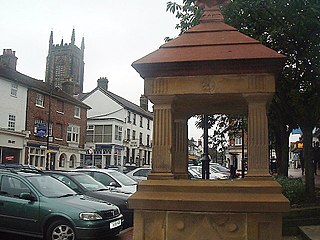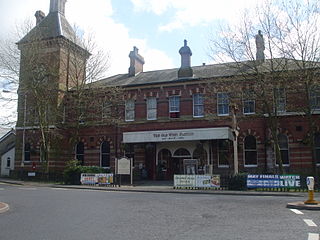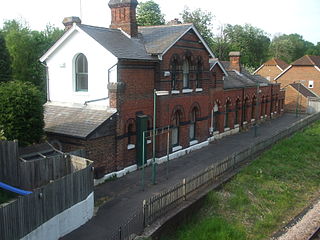
The Bluebell Railway is an 11 mi (17.7 km) heritage line almost entirely in West Sussex in England, except for Sheffield Park which is in East Sussex. It is managed by the Bluebell Railway Preservation Society. It uses steam trains which operate between Sheffield Park and East Grinstead, with intermediate stations at Horsted Keynes and Kingscote.

East Grinstead is a town in West Sussex, England, near the East Sussex, Surrey, and Kent borders, 27 miles (43 km) south of London, 21 miles (34 km) northeast of Brighton, and 38 miles (61 km) northeast of the county town of Chichester. Situated in the extreme northeast of the county, the civil parish has an area of 2,443.45 hectares. The population at the 2011 Census was 26,383.

The Spa Valley Railway (SVR) is a standard gauge heritage railway that runs from Tunbridge Wells West railway station in Tunbridge Wells to High Rocks, Groombridge, and Eridge, where it links with the Oxted Line.

The Lavender Line is a heritage railway based at Isfield Station, near Uckfield in East Sussex, England.

The Oxted line is a railway in southern England and part of the Southern franchise. The railway splits into two branches towards the south and has direct trains throughout to London termini.

East Grinstead railway station is one of the two southern termini of the Oxted line in the south of England and serves East Grinstead in West Sussex. It is 30 miles 4 chains from London Bridge, although trains mostly run to and from London Victoria. The station is managed by Southern.

Barcombe is an East Sussex village and civil parish in the Lewes District of East Sussex. The parish has four settlements: old Barcombe, the oldest settlement in the parish with the parish church; Barcombe Cross, the more populous settlement and main hub with the amenities and services; the hamlet of Spithurst in the north east and Town Littleworth in the north west.

Groombridge is a village of about 1,600 people. It straddles the border between Kent and East Sussex, in England. The nearest large town is Royal Tunbridge Wells, about 4.5 miles (7.2 km) away by road.

The Worth Way is a 7-mile (11 km) footpath and bridleway linking the West Sussex towns of Crawley and East Grinstead via the village of Crawley Down. Mostly following the trackbed of a disused railway the path is an important wildlife corridor. It is part of the National Cycle Network.

Tunbridge Wells West is a railway station located in Royal Tunbridge Wells, Kent. It is one of two railway stations in Tunbridge Wells constructed by rival companies. The other, Tunbridge Wells Central was opened in 1845 by the South Eastern Railway (SER). Tunbridge Wells West was closed to mainline passenger services in 1985, but part of it still remains as a heritage railway line. Opened in 1996, it stands next to the original engine shed. The line is called the Spa Valley Railway.

Sheffield Park is the southern terminus of the Bluebell Railway and also the headquarters of the line. It is located on the southern bank of the River Ouse and is also situated on the Greenwich Meridian.

Groombridge railway station is a station on the Spa Valley Railway (SVR) in Groombridge, East Sussex, England. Once a busy station serving four directions, it closed in 1985 to British Rail services. A new station the other side of Station Road bridge was opened by the SVR in 1997 as part of a standard gauge heritage railway to Tunbridge Wells West.
The Three Bridges–Tunbridge Wells line is a mostly disused railway line running from Three Bridges in West Sussex to Tunbridge Wells Central in Kent via East Grinstead in West Sussex, a distance of 20 miles 74 chains (33.7 km). Opened in 1855, the main section of the line was a casualty of the Beeching Axe – the last train ran on 1 January 1967. The remaining section to Tunbridge Wells closed on 6 July 1985, although the section between Groombridge and Tunbridge Wells West was reopened in 1997 under the auspices of the Spa Valley Railway.
The Wealden Line is a partly abandoned double track railway line in East Sussex and Kent that connected Lewes with Tunbridge Wells, a distance of 25.25 miles (40.64 km). The line takes its name from the Weald, the hilly landscape the lies between the North and South Downs.

Barcombe was a railway station serving the village of Barcombe in East Sussex. It was part of the East Grinstead to Lewes line, part of which now makes up the Bluebell Railway. The station was originally opened as "New Barcombe" to distinguish it from the nearby station of Barcombe Mills and was changed to its more usual name on 1 January 1885. In 1897 goods sidings were installed at a cost of £1450.

Barcombe Mills is a disused railway station in the hamlet of Barcombe Mills, on the closed section of the Wealden Line. The station was opened in 1858 and closed in 1969.

The High Weald Landscape Trail (HWLT) is a 145-kilometre (90 mi) route in England between Horsham, West Sussex and Rye, East Sussex, designed to pass through the main landscape types of the High Weald Area of Outstanding Natural Beauty (AONB). It does not follow the highest ground, and the eastern section is only a few feet above sea level. It keeps to the northern edge of the High Weald except in the west where it runs close to the southern edge for a short distance.

The Forest Way is a linear Country park providing walking, cycling, horse riding and the quiet enjoyment of the countryside. It runs for around 16 km from East Grinstead to Groombridge.
Bernard John Holden MBE was an English railway engineer and manager with Southern and British Railways and a founding father of standard gauge railway preservation in the United Kingdom. He was President of the Bluebell Railway in Sussex for over twenty years until his death.
Thomas Harrison Myres FRIBA was an English railway architect who designed stations and ancillary buildings for the London, Brighton & South Coast Railway lines that were opened between 1880 and 1883, including several on what is now the Bluebell Railway. He was the son-in-law of the railway company's chief engineer, Frederick Banister. Although most of the lines for which Myres designed the buildings have been closed, many of his buildings survive as private residences. Several of the buildings designed by him are listed buildings, including the goods shed at Singleton in West Sussex which was declared Grade II in April 2013.



















